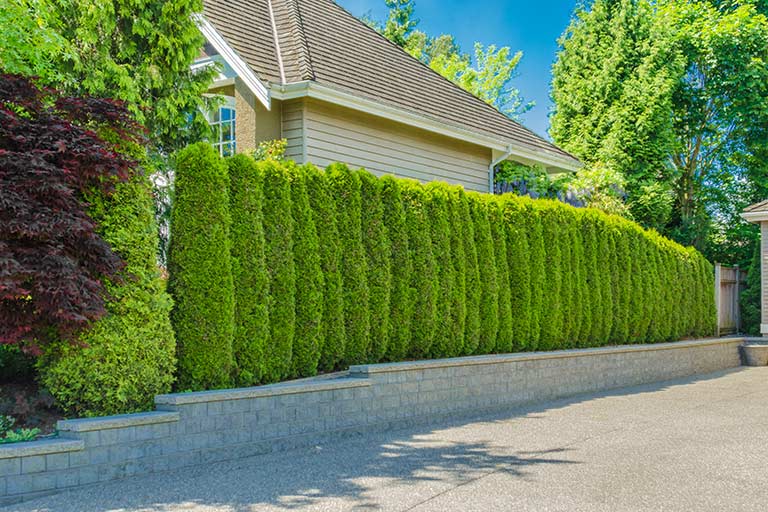In the hustle and bustle of modern life, finding solace and seclusion in our outdoor spaces has become increasingly essential. Whether it’s enjoying a quiet morning coffee on the patio or hosting a backyard barbecue with friends, having privacy in our outdoor environments is paramount. One of the most effective ways to achieve outdoor privacy is by strategically incorporating trees into our landscape design.
This blog aims to delve into the process of planning and implementing your very own tree privacy project, from conception to canopy.
Understanding Your Privacy Needs
Before diving into the world of tree selection and placement, it’s crucial to assess your privacy requirements and goals. Consider factors such as the proximity to neighbours, visibility from surrounding areas, and the level of noise reduction desired.
Factors to Consider:
- Proximity to Neighbours: Evaluate the distance between your property and neighbouring homes or buildings to determine the degree of privacy needed.
- Visibility from Surrounding Areas: Assess the sightlines from nearby streets, parks, or other properties to identify potential privacy gaps.
- Noise Reduction Requirements: Determine the extent to which you want your privacy trees to mitigate outdoor noise pollution and create a tranquil environment.
Determining the level of privacy desired sets the foundation for the rest of your tree privacy project.
Choosing the Right Trees for Privacy

Researching suitable tree species for your climate and location is key to the success of your privacy project. Consider characteristics such as height, density, growth rate, and foliage type when selecting your privacy trees.
Characteristics to Look For:
- Height: Choose trees that grow to the desired height to effectively screen your outdoor space from view.
- Density: Opt for trees with dense foliage or branching patterns to create a solid barrier and enhance privacy.
- Growth Rate: Select trees with moderate to fast growth rates to expedite the establishment of your privacy landscape.
- Foliage Type: Consider evergreen trees for year-round privacy or deciduous trees for seasonal variation and added visual interest.
Aesthetics and maintenance requirements should also be taken into account to ensure your privacy trees complement your outdoor space seamlessly.
Planning Your Tree Placement
Assess your outdoor space and identify potential planting areas where trees can effectively provide privacy. Determine the optimal placement for maximum privacy by considering factors, such as sunlight exposure, soil conditions, existing landscaping features, and space constraints.
Tips for Optimal Placement:
- Consider the Angle of the Sun Throughout the Day: Position trees to provide shade and privacy during peak sunlight hours, especially in areas where you spend the most time outdoors.
- Evaluate Soil Drainage and Quality: Choose planting locations with well-draining soil to promote healthy root development and prevent waterlogging.
- Account for Future Tree Growth and Space Requirements: Allow ample space between trees and existing structures to accommodate their mature size and prevent overcrowding in your landscape.
Designing Your Privacy Landscape

Creating a comprehensive plan for your tree privacy project involves more than just planting trees. Incorporating elements such as shrubs, hedges, fences, and natural barriers can enhance privacy and add visual interest to your landscape.
Tips on Incorporating Other Elements:
- Use a Combination of Trees and Shrubs for Layered Privacy: Mix and match different plant heights and textures to create a diverse and visually appealing privacy screen.
- Consider Installing Trellises or Lattice Panels for Additional Screening: Train climbing vines or ivy to grow on trellises or fences to increase privacy without sacrificing space.
- Incorporate Natural Barriers like Rock Formations or Berms: Integrate natural features into your landscape design to enhance privacy and create a cohesive outdoor environment.
Balancing privacy needs with aesthetic considerations ensures a harmonious and inviting outdoor space.
Implementing Your Tree Privacy Project
Sourcing quality trees and materials is essential for the success of your privacy project. Proper tree planting techniques and spacing considerations are crucial for the health and vitality of your privacy trees.
Techniques for Successful Implementation:
- Choose Healthy, Well-Rooted Trees from Reputable Nurseries: Select trees with robust root systems and vibrant foliage to ensure they thrive in their new environment.
- Dig Planting Holes Twice as Wide as the Root Ball but No Deeper: Provide ample space for root expansion and avoid burying the trunk to prevent moisture-related issues and root rot.
- Mulch Around the Base of the Tree to Retain Moisture and Suppress Weeds: Apply a layer of organic mulch to conserve soil moisture, regulate temperature, and discourage weed growth around the tree’s root zone.
Following these techniques will help ensure the successful establishment and growth of your privacy trees.
Tree Maintenance and Care
Establishing a maintenance schedule for your privacy trees is vital for their long-term health and vitality. Proper pruning, watering, fertilizing, and pest management are essential tasks to keep your privacy landscape thriving.
Maintenance Guidelines
- Prune Dead or Diseased Branches Regularly: Remove dead, damaged, or diseased branches to promote healthy growth and prevent the spread of pathogens.
- Water Deeply and Infrequently to Encourage Deep Root Growth: Apply water at the base of the tree in slow, deep watering sessions to encourage roots to grow deeper into the soil and improve drought tolerance.
- Apply a Slow-Release Fertilizer in Early Spring to Promote Healthy Foliage: Provide essential nutrients to support vigorous growth and vibrant foliage throughout the growing season.
Addressing common issues such as pests, diseases, and environmental stressors promptly helps maintain the integrity of your privacy landscape.
Monitoring and Adjustments
Regularly evaluate the effectiveness of your privacy landscape and make adjustments as trees grow and landscape conditions change. Monitoring tree health, pruning as needed, and maintaining proper spacing between plants ensures long-term privacy and sustainability.
Planning and implementing a tree privacy project can transform your outdoor space into a tranquil sanctuary. By understanding your privacy needs, choosing the right trees, and implementing proper care and maintenance practices, you can create a landscape that provides both privacy and beauty. We encourage you to embark on your tree privacy project and experience the joys of outdoor seclusion. Remember, the beauty of privacy trees goes beyond mere aesthetics—it’s about creating a space that enhances your quality of life.
For expert guidance and high-quality privacy trees in Mississauga, contact us at (905) 880-1828. Let us help you create the privacy oasis you’ve always dreamed of.

